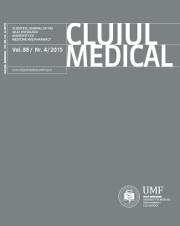Factors involved in the etiology of temporomandibular disorders - a literature review
DOI:
https://doi.org/10.15386/cjmed-485Keywords:
temporomandibular joint disorder, etiology, factor, pathogenesisAbstract
Background and aim. This review aims at presenting a current view on the most frequent factors involved in the mechanisms causing temporomandibular disorders (TMD).
Method. We conducted a critical review of the literature for the period January 2000 to December 2014 to identify factors related to TMD development and persistence.
Results. The etiology of TMD is multidimensional: biomechanical, neuromuscular, bio-psychosocial and biological factors may contribute to the disorder. Occlusal overloading and parafunctions (bruxism) are frequently involved as biomechanical factors; increased levels of estrogen hormones are considered biological factors affecting the temporo-mandibular-joint. Among bio-psychosocial factors, stress, anxiety or depression, were frequently encountered.
Conclusions. The etiopathogenesis of this condition is poorly understood, therefore TMDs are difficult to diagnose and manage. Early and correct identification of the possible etiologic factors will enable the appropriate treatment scheme application in order to reduce or eliminate TMDs debilitating signs and symptoms.
Downloads
Additional Files
Published
How to Cite
Issue
Section
License
The authors are required to transfer the copyright of the published paper to the journal. This is done by agreeing to sign the Copyright Assignment Form. Whenever the case, authors are also required to send permissions to reproduce material (such as illustrations) from the copyright holder.

The papers published in the journal are licensed under a Creative Commons Attribution-NonCommercial-NoDerivatives 4.0 International License.

